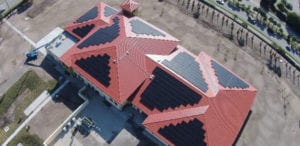Tax Benefits of the IRA for Commercial Solar (Click to download)
Starting in 2005, the US Congress passed the first law to allow homeowners and businesses to obtain a 30% tax credit for installing solar panels. Congress anticipated the bill would provide an incentive for the growth of sustainable and renewable sources of energy. The tax credit had a sunset provision attached to it, which was originally set to end in 2007.
The popularity of the tax credit led Congress to pass extensions. Most recently, in August of 2022, the government passed into law the Inflation Reduction Act, the most significant investment in clean energy in U.S. history.
What is the Solar Investment Tax Credit (ITC)?
The Inflation Reduction Act restores and increases the Solar Investment Tax Credit (ITC). With the passing of IRA, businesses that install solar photovoltaic (PV) systems are eligible to receive a tax credit that can be used to directly offset federal taxes owed on a dollar-for-dollar basis for up to 30% of the cost of a solar project. This is a meaningful change for businesses, as the ITC before IRA was lower (26%) and set to further decline and expire after 2023.
Under IRA, the ITC for commercial solar projects is extended until 2025. Tax credits in 2025 and later are contingent upon whether certain emission reduction goals set forth by the Department of Treasury are met.

How Does the Federal Solar Tax Credit Work?
Through 2025, the solar tax credit will provide a 30% tax credit on the cost of installing residential or commercial solar systems. Since its inception in 2006, the credit has contributed to growth of more than 5,000% in the US solar industry. In the past decade, the growth in solar use throughout the country has averaged more than 50% annually. Solar currently provides only 2.5% of American energy needs so there is room for additional growth.
The tax credit is better than a mere deduction that reduces taxable income. This is tax credit, which reduces the total amount of income tax you owe. The credit would apply to the cost associated with the installation of a new solar system. Therefore, a solar system that costs $1,000,000 to install would save you $300,000 on your income tax. If your business is looking to invest in a solar power system, now is the time.
What Tax Incentives Does Your Business Qualify For?
To take full advantage of the incentives offered under the Inflation Reduction Act, there are many nuanced provisions and requirements to consider. Variables like project size, region, construction commencement date, and more can have a significant impact on a company’s total incentive value.
The solar credit applies to most if not all expenses related to the installation of new solar panels. This would include:
- Consultation fees
- Solar panels
- Shipping
- Installer fees
- Costs associated with permitting
- Engineer or electrician fees
You can install the panels yourself if you have the necessary expertise, but you cannot include charges for your own labor to claim a higher cost basis. You’ll want to keep all receipts as proof of your expenses related to the installation of a new system in case of an audit from the IRS. To actually claim the credit, you’ll need to complete Form 3468 if your business files a Schedule C as a part of Form 1040
on your personal return. Corporations will need to fill out Form 1120 rather than Form 1040.
How Does Solar Energy Save Money for Businesses?
Back when the solar tax credit first passed in 2006, the installation of solar panels was cost prohibitive. In the years since, the technology has become much less of a financial burden. That means the tax credit will be worth less than it was back in 2006, but the overall cost of producing electricity from solar energy has come down enough that the total financial benefits will be worth more than they were at that time.
If you’re a business owner, this should be music to your ears. The overall cost to produce solar energy is about one-third what it was back in 2010. Even with a lower tax credit in terms of the absolute dollar amount, solar technology is becoming much more cost-effective for businesses. Even nonprofits that do not pay income taxes will also stand to benefit from installing a photovoltaic system to provide electricity. It’s great for your bottom line, and the environment.
If you’re thinking about installing a solar system for your business, there is an additional benefit. Many states allow homes and businesses to sell electricity back to the grid. This means not only will you be saving money, but you could also be making money.
When you produce more electricity than you need, you can send it to the electric company and get paid for it in some locations. The amount you’ll get paid is at the utility company’s avoided cost. Even though it’s not what you’ll pay for retail electricity, it’s still better than nothing. It’s a good idea to check if your state will allow you to sell electricity back to the grid and what the specific requirements are in your locality.
Tax Credit as Part of a Solar Financing
If you’re looking to save money on a commercial solar project, it’s important to consider the impact of the Inflation Reduction Ace and its Solar Investment Tax Credit. Combined with other local and state incentives, you can quickly see a return-on-investment. If you’re thinking of pulling the trigger on solar, contact HOLT Renewables today and we’ll put together a comprehensive solar assessment.
